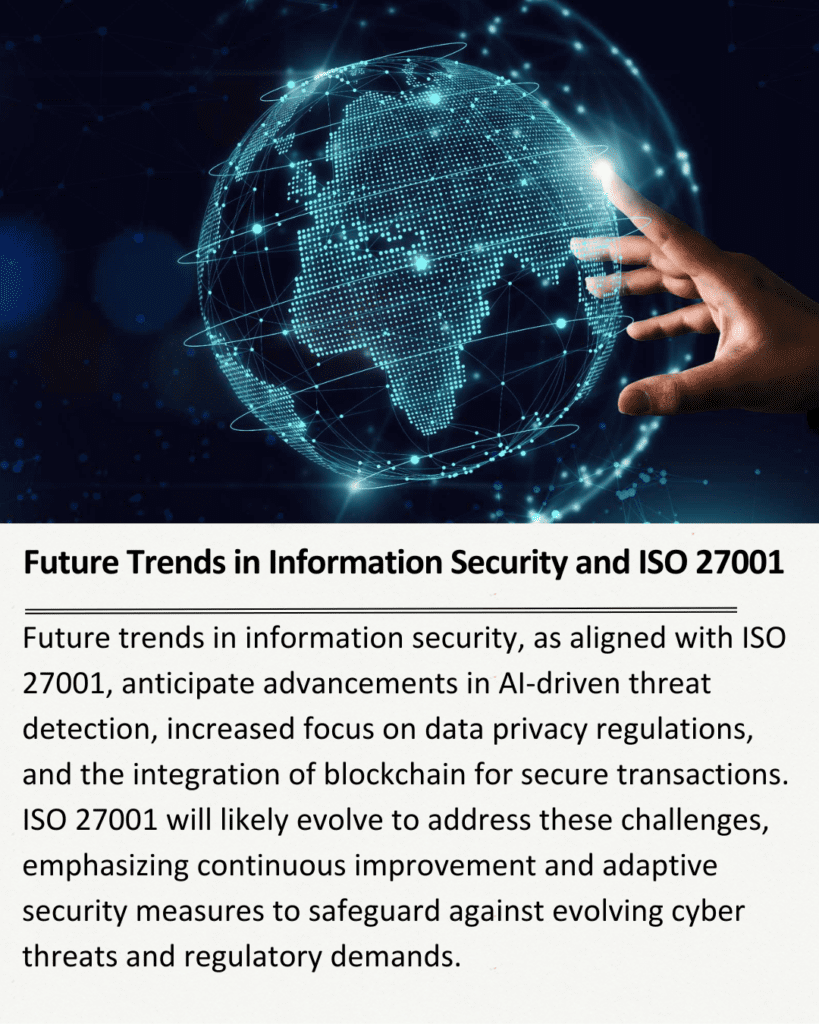Subtotal $0.00

In the rapidly evolving landscape of information security, staying ahead of emerging threats and technologies is crucial for organizations aiming to protect their assets and maintain trust with stakeholders. ISO 27001, a cornerstone in information security management systems (ISMS), continually adapts to address new challenges and integrate innovative solutions. This article explores future trends, predictions, and emerging technologies in information security, focusing on their implications for ISO 27001.
1. Artificial Intelligence and Machine Learning in Cybersecurity
Artificial Intelligence (AI) and Machine Learning (ML) are transforming cybersecurity by enhancing threat detection, incident response, and anomaly detection. AI-powered systems can analyze vast amounts of data in real-time to identify patterns and anomalies that human analysts might miss. For ISO 27001, integrating AI/ML into risk assessments and monitoring processes enhances the ability to proactively mitigate risks and respond to threats swiftly.
2. Quantum Computing and Encryption
The advent of quantum computing poses both opportunities and challenges for encryption methods currently relied upon for data protection. While quantum computing promises unprecedented computing power, it also threatens to break traditional encryption algorithms used to secure sensitive information. ISO 27001 will likely need to adapt by exploring quantum-resistant cryptography and updating encryption standards to withstand future quantum threats.
3. Zero Trust Architecture (ZTA)
Zero Trust Architecture (ZTA) is gaining prominence as a security model that assumes breaches are inevitable and trusts no one inside or outside the network perimeter. ZTA verifies every request as though it originates from an open network, regardless of whether it is external or internal. ISO 27001 can incorporate ZTA principles to strengthen access controls, segmentation, and continuous monitoring, thereby enhancing overall security posture.
4. Internet of Things (IoT) Security
The proliferation of IoT devices presents significant security challenges, as these devices often have limited computational power and lack robust security measures. ISO 27001 may need to address IoT-specific risks through guidelines for secure development practices, lifecycle management, and integration with broader ISMS frameworks to ensure comprehensive protection of interconnected systems.
5. Blockchain Technology
Blockchain technology offers decentralized and tamper-resistant transaction records, making it valuable beyond cryptocurrency applications. In information security, blockchain can enhance data integrity, secure supply chain transactions, and improve identity management. ISO 27001 might explore standards for securely implementing blockchain within organizational environments, ensuring compatibility with existing security controls and regulatory requirements.
6. Privacy-Enhancing Technologies (PETs)
With increasing regulatory focus on data privacy (e.g., GDPR, CCPA), Privacy-Enhancing Technologies (PETs) are becoming essential for organizations handling sensitive personal information. PETs include encryption, anonymization, and differential privacy techniques designed to protect user privacy while enabling data-driven insights. ISO 27001 could expand guidelines on integrating PETs into ISMS frameworks to ensure compliance with evolving privacy regulations.
7. Cybersecurity Automation and Orchestration
Automation and orchestration streamline security operations by automating repetitive tasks, orchestrating workflows across disparate security tools, and enabling rapid incident response. ISO 27001 can leverage automation to improve incident detection and response times, reduce human error, and optimize resource allocation for proactive security measures.
8. Regulatory Compliance and Global Standards
The landscape of regulatory compliance continues to evolve globally, with stricter data protection laws and industry-specific regulations shaping information security practices. ISO 27001 will likely evolve to align with these regulations, providing frameworks and guidelines that help organizations achieve and maintain compliance while enhancing overall security resilience.
Conclusion
As technology advances and threats become more sophisticated, the role of ISO 27001 in ensuring robust information security management becomes increasingly vital. By embracing emerging technologies and adapting to future trends, ISO 27001 not only helps organizations mitigate risks but also fosters a proactive approach to cybersecurity that anticipates and responds to evolving threats and regulatory requirements. Organizations that integrate these predictions and technologies into their ISMS frameworks stand better positioned to safeguard sensitive information, maintain trust with stakeholders, and achieve sustainable business resilience in the digital age.